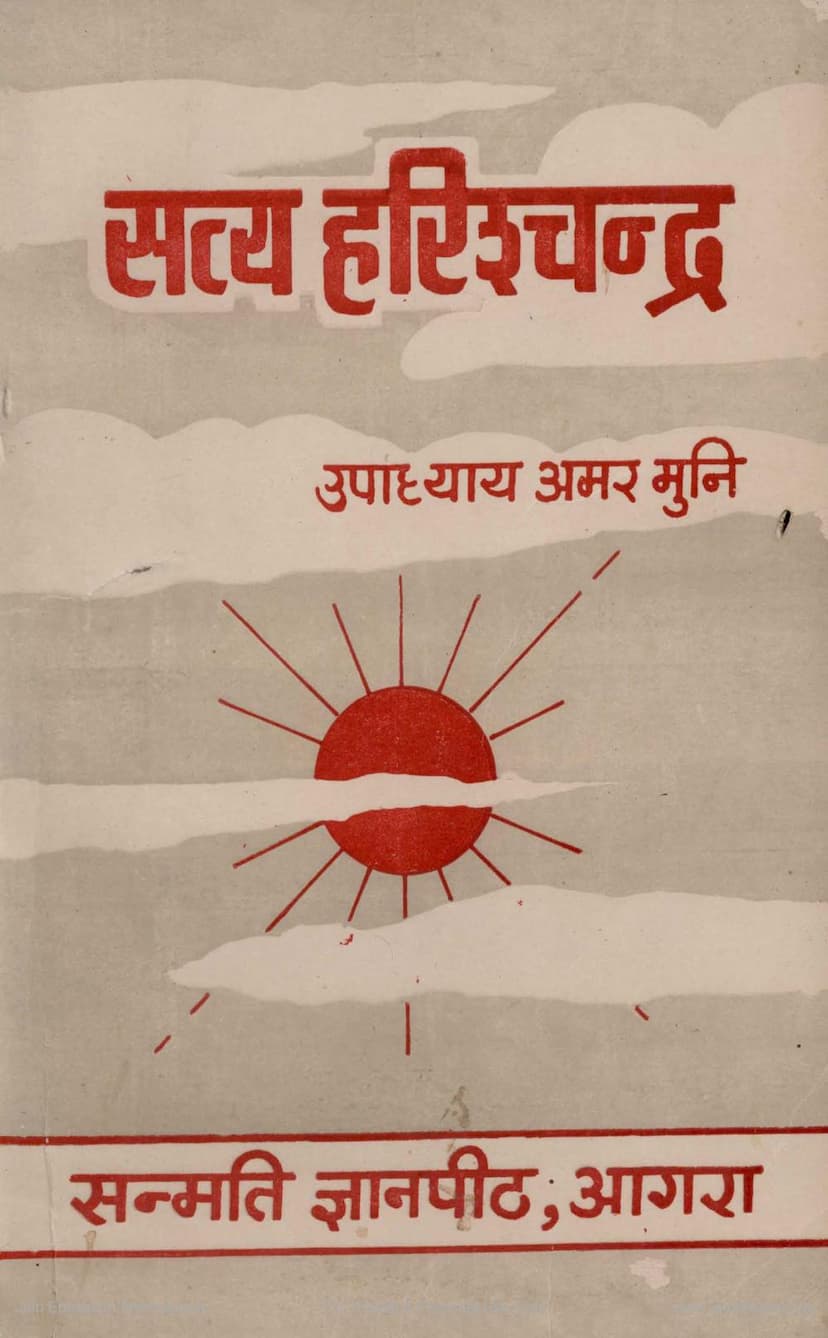Satya Harischandra
Added to library: September 2, 2025

Summary
The book "Satya Harischandra" by Upadhyay Amarmuni, published by Sanmati Gyan Pith Agra, is a poetic rendition of the life and trials of King Harishchandra, a figure renowned for his unwavering commitment to truth and righteousness, particularly within the Jain tradition.
The book's preface, or "Atma-nivedan" (Self-dedication), highlights King Harishchandra's life as an ideal for humanity, a beacon of truth, even when it meant sacrificing his wife and selling himself due to his adherence to the "Asidharavrata" (a vow of severe austerity involving walking on a sword's edge). The author humbly presents this work as a vessel for the essence of Harishchandra's pure life, urging readers to focus on the sentiments rather than the imperfections of his words.
The publisher's note emphasizes Upadhyay Amarmuni's stature as a profound thinker, scholar of Jain scriptures, philosopher, and litterateur. It positions "Satya Harischandra" not only as a poetically complete work but also as a source of inspiration to cultivate the spirit of truth and good deeds, enabling individuals to persevere through life's struggles. The second edition is dedicated to readers who have long awaited it.
The introductory sections further elaborate on the profound connection between poetry, truth, and the human spirit. Poetry is seen as an expression of life, capable of discerning beauty and deriving joy from it. The pursuit of 'Sat' (truth) is presented as an inherent human desire, leading to virtue and goodness. The book argues that poetry, as a reflection of the inner self, cannot be separated from 'Sat', which is ultimately synonymous with auspiciousness and beauty.
Harishchandra's life is presented as a unique and inspiring example in human existence. The author's skill in portraying Harishchandra's character, supported by his innate understanding, compassion, and moral fortitude, transforms the narrative into a work for the welfare and happiness of many. The text underscores the paramount importance of truth in human life, questioning what instruments humans possess to claim superiority and what path leads to it. The author laments the present degradation of truthfulness and the fading of integrity in spoken words, contrasting it with the past where men stood by their promises, even unto death.
The narrative then delves into the challenges faced by Harishchandra. The allure of worldly pleasures, the beauty of his queen, Tara, and the opulence of his palace initially lead him away from his duties. However, Queen Tara, though seemingly caught in the web of luxury, remains steadfast in her concern for the people's welfare. She understands that true beauty lies not in the confines of the palace but in the boundless expanse of nature, where harmony and inspiration for action can be found. The poem reflects on the importance of acquiring virtues and the folly of chasing mere prestige.
The text then highlights the author's skill in teaching the virtue of renunciation even within domestic life. It emphasizes the author's compassionate nature, which permeates both his literary works and his personality. Harishchandra's legendary act of donating his entire kingdom to Vishwamitra, leaving him spiritually lighter, is depicted. His subsequent journey with his wife and son towards Kashi for self-sale is portrayed as a testament to his unwavering adherence to truth, even when faced with extreme hunger. His commitment to earning his sustenance through honest labor, upholding Kshatriya dharma, is emphasized.
The author also reflects on the stark contrast between the wealthy and the impoverished, the pain of suffering caused by neglect, and the poet's empathy for the distressed humanity of the present era. The book draws a parallel with Van Gogh's passion for painting humanity, asserting that humanity in its highest form can elevate individuals to a divine status. True experience, it is argued, comes from merging one's own joys and sorrows with those of others. The author poses a question about why humans don't contemplate this during moments of introspection and highlights the insult to humanity when the suffering of others is disregarded.
The story of Queen Tara's sacrifice, becoming a servant to repay her husband's debts, enduring hardship and contempt, fueled by the hope of her son Rohit's redemption, is presented. The tragic death of Rohit, her beloved son, is recounted, leading to Tara's profound grief and lament. The narrative then contrasts Tara's sorrow with the indifference of the Brahmin's son, who views her as a mere servant and her pain as inconsequential. This juxtaposition powerfully illustrates the societal divide and the dehumanizing effects of ownership and power.
The text concludes that the epic poem "Satya Harischandra" is a work that embodies the ideal of humanity and the profound expression of compassion. It is described as having vigor, flow, and imaginative depth, worthy of being called a "Mahakavya" (great epic). Harishchandra and his character are deemed complete in themselves, making the work stand apart from lesser forms of poetry. The author's clarity of language and purpose, aiming to foster human excellence in the common person, is lauded. The book is believed to be instrumental in furthering this noble objective.
The book is structured into chapters covering the introduction, Harishchandra's reign, the illusion of attachment, awakening, reunion, Indra's assembly, Vishwamitra's intervention, bondage and liberation, Vishwamitra's wrath, the courtroom, ideal dialogue, donation of the kingdom, love for the subjects, the ideal wife, departure, Vishwamitra's usurpation of the kingdom, the forest path, in Kashi, concern for debt, Vishwamitra's demand, self-sale, the maidservant, the slave, independent Rohit, the thunderbolt of calamity, the final test, and the victory of truth, culminating in a conclusion and eulogy.